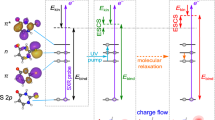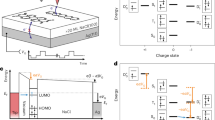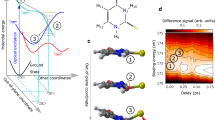Abstract
Electron-density distributions and potential-energy surfaces are important for predicting the physical properties and chemical reactivity of molecular systems. Whereas angle-resolved photoelectron spectroscopy enables the reconstruction of molecular-orbital densities of condensed species1, absorption or traditional photoelectron spectroscopy are widely employed to study molecular potentials of isolated species. However, the information they provide is often limited because not all vibrational substates are excited near the vertical electronic transitions from the ground state. Moreover, many electronic states cannot be observed owing to selection rules or low transition probabilities. In many other cases, the extraction of the potentials is impossible owing to the high densities of overlapping electronic states. Here we use resonant photoemission spectroscopy, where the absence of strict dipole selection rules in Auger decay enables access to a larger number of final states as compared with radiative decay. Furthermore, by populating highly excited vibrational substates in the intermediate core-excited state, it is possible to ‘pull out’ molecular states that were hidden by overlapping spectral regions before.
This is a preview of subscription content, access via your institution
Access options
Subscribe to this journal
Receive 12 print issues and online access
$259.00 per year
only $21.58 per issue
Buy this article
- Purchase on SpringerLink
- Instant access to full article PDF
Prices may be subject to local taxes which are calculated during checkout




Similar content being viewed by others
Change history
19 November 2015
In the version of this Letter originally published the state with Emin = 23 eV was mislabelled throughout and should have been labelled 12ϕg. This has been corrected in the online versions 19 November 2015.
References
Puschnig, P. et al. Reconstruction of molecular orbital densities from photoemission data. Science 326, 702–706 (2009).
Huber, K. P. & Herzberg, G. Molecular Spectra and Molecular Structure, Vol. 4: Constants of Diatomic Molecules (Van Nostrand Reinhold, 1979).
Itatani, J. et al. Tomographic imaging of molecular orbitals. Nature 432, 867–871 (2004).
Steele, D. & Lippincott, E. R. Comparative study of empirical internuclear potential functions. Rev. Mod. Phys. 34, 239–251 (1962).
Prince, K. C. et al. A critical comparison of selected 1s and 2p core hole widths. J. Electron Spectrosc. Related Phenom. 101–103, 141–147 (1999).
Travnikova, O. et al. Circularly polarized X rays: Another probe of ultrafast molecular decay dynamics. Phys. Rev. Lett. 105, 233001 (2010).
Söderström, J. et al. Angle-resolved electron spectroscopy of the resonant Auger decay in xenon with meV energy resolution. New J. Phys. 13, 073014 (2011).
Gel’mukhanov, F. & Ågren, H. Resonant X-ray Raman scattering. Phys. Rep. 312, 87–330 (1999).
Piancastelli, M-N. Auger resonant Raman studies of atoms and molecules. J. Electron Spectrosc. Related Phenom. 107, 1–26 (2000).
Ueda, K. Core excitation and de-excitation spectroscopies of free atoms and molecules. J. Phys. Soc. Jpn 75, 032001 (2006).
Miron, C. & Morin, P. in Handbook of High-Resolution Spectroscopy (eds Quack, M. & Merkt, F.) 1655–1690 (John Wiley, 2011).
Miron, C. et al. Nuclear motion driven by the Renner–Teller effect as observed in the resonant Auger decay to the X electronic ground state in N2O. J. Chem. Phys. 115, 864–868 (2001).
Miron, C. et al. Mapping potential energy surfaces by core excitation of polyatomic molecules. Chem. Phys. Lett. 359, 48–54 (2002).
Miron, C. et al. Vibrational scattering anisotropy generated by multichannel quantum interference. Phys. Rev. Lett. 105, 093002 (2010).
Liu, J-C. et al. Multimode resonant Auger scattering from the ethene molecule. J. Phys. Chem. B 115, 5103–5112 (2011).
Gel’mukhanov, F. & Ågren, H. X-ray resonant scattering involving dissociative states. Phys. Rev. A 54, 379–393 (1996).
Carniato, S. et al. K-L resonant X-ray Raman scattering as a tool for potential energy surface mapping. Chem. Phys. Lett. 439, 402–406 (2007).
Lim, T-C. Modification of Morse potential in conventional force fields for applying FPDP parameters. J. Math. Chem. 47, 984–989 (2010).
Namioka, T., Yoshino, K. & Tanaka, Y. Isotope bands and the vibration assignment of the D2Πg−A2Πu system of N2+. J. Chem. Phys. 39, 2629–2633 (1963).
Kosugi, N. & Kuroda, H. Efficient methods for solving the open-shell SCF problem and for obtaining an initial guess. The one-Hamiltonian and the partial SCF methods. Chem. Phys. Lett. 74, 490–493 (1980).
Kosugi, N. Strategies to vectorize conventional SCF-Cl algorithms. Theor. Chim. Acta 72, 149–173 (1987).
Huzinaga, S. et al. Physical Sciences Data Vol. 16 (Elsevier, 1984).
Baltzer, P., Larsson, M., Karlsson, L., Wannberg, B. & Göthe, M-C. Inner-valence states of N2+ studied by UV photoelectron spectroscopy and configuration-interaction calculations. Phys. Rev. A 46, 5545–5553 (1992).
Langhoff, S. R. & Bauschlicher, C. W. Jr Theoretical study of the first and second negative systems of N+2 . J. Chem. Phys. 88, 329–336 (1988).
Honjou, N. & Miyoshi, E. An ab initio study on the electronic structure of the 32Σu+, 32Σg+ and 42Σg+ states of N+2 . J. Mol. Struct. 451, 41–49 (1998).
Yoshii, H., Tanaka, T., Morioka, Y., Hayaishi, T. & Hall, R. I. New N2+ electronic state in the region of 23–28 eV. J. Mol. Spectrosc. 186, 155–161 (1997).
Aoto, T. et al. Inner-valence states of N2+ and the dissociation dynamics studied by threshold photoelectron spectroscopy and configuration interaction calculation. J. Chem. Phys. 124, 234306 (2006).
Nicolas, C. et al. Dissociative photoionization of N2 in the 24–32 eV photon energy range. J. Phys. B 36, 2239–2251 (2003).
Sałek, P., Gel’mukhanov, F. & Ågren, H. Wave-packet dynamics of resonant x-ray Raman scattering: Excitation near the Cl LII,III edge of HCl. Phys. Rev. A 59, 1147–1159 (1999).
Sałek, P. A wave-packet technique to simulate resonant X-ray scattering cross sections. Comput. Phys. Commun. 150, 85–98 (2003).
Piancastelli, M-N. et al. Electron decay following the N 1s→π* excitation in N2 studied under resonant Raman conditions. J. Electron Spectrosc. Related Phenom. 98–99, 111–120 (1999).
Acknowledgements
Experiments were carried out at the PLEIADES beamline at SOLEIL Synchrotron, France (proposal number 99090106). We are grateful to J. B. A. Mitchell for his suggestions, to E. Robert for technical assistance and to the SOLEIL staff for smoothly running the facility. The research leading to these results has received funding from the European Union Seventh Framework Programme (FP7/2007-2013) under grant agreement 252781, from Triangle de la physique under contract 2007-010T, from JSPS and from the Swedish Research Council.
Author information
Authors and Affiliations
Contributions
C.M. suggested and planned the experiment. C.N., O.T. and C.M. collected the data, and V.K. and O.T. carried out the data analysis. Y.S., F.G., N.K. and V.K. carried out the theoretical analysis. C.M., F.G. and V.K. wrote the paper and O.T. contributed to figure production. All authors discussed the results and commented on the manuscript.
Corresponding author
Ethics declarations
Competing interests
The authors declare no competing financial interests.
Supplementary information
Supplementary Information
Supplementary Information (PDF 546 kb)
Rights and permissions
About this article
Cite this article
Miron, C., Nicolas, C., Travnikova, O. et al. Imaging molecular potentials using ultrahigh-resolution resonant photoemission. Nature Phys 8, 135–138 (2012). https://doi.org/10.1038/nphys2159
Received:
Accepted:
Published:
Issue date:
DOI: https://doi.org/10.1038/nphys2159
This article is cited by
-
First in-flight synchrotron X-ray absorption and photoemission study of carbon soot nanoparticles
Scientific Reports (2016)
-
Ground state potential energy surfaces around selected atoms from resonant inelastic x-ray scattering
Scientific Reports (2016)
-
Einstein–Bohr recoiling double-slit gedanken experiment performed at the molecular level
Nature Photonics (2015)
-
Erratum: Corrigendum: Imaging molecular potentials using ultrahigh-resolution resonant photoemission
Nature Physics (2015)
-
Site-selective photoemission from delocalized valence shells induced by molecular rotation
Nature Communications (2014)



